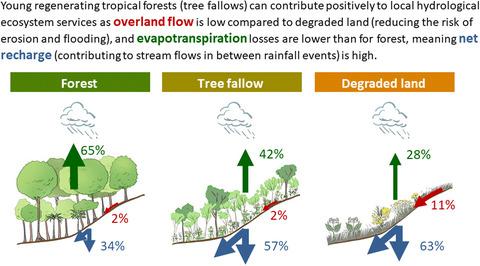当前位置:
X-MOL 学术
›
J. Appl. Ecol.
›
论文详情
Our official English website, www.x-mol.net, welcomes your
feedback! (Note: you will need to create a separate account there.)
Forest regeneration can positively contribute to local hydrological ecosystem services: Implications for forest landscape restoration
Journal of Applied Ecology ( IF 5.0 ) Pub Date : 2021-02-22 , DOI: 10.1111/1365-2664.13836 H. J. (Ilja) van Meerveld 1 , Julia P. G. Jones 2 , Chandra P. Ghimire 3 , Bob W. Zwartendijk 1, 4 , Jaona Lahitiana 5 , Maafaka Ravelona 5 , Mark Mulligan 6
中文翻译:

森林更新可以为当地水文生态系统服务做出积极贡献:对森林景观恢复的影响
更新日期:2021-04-08
Journal of Applied Ecology ( IF 5.0 ) Pub Date : 2021-02-22 , DOI: 10.1111/1365-2664.13836 H. J. (Ilja) van Meerveld 1 , Julia P. G. Jones 2 , Chandra P. Ghimire 3 , Bob W. Zwartendijk 1, 4 , Jaona Lahitiana 5 , Maafaka Ravelona 5 , Mark Mulligan 6
Affiliation

|
- Governments are increasingly committing to significant forest restoration. While carbon sequestration is a major objective, the case for restoration often includes benefits to local communities. However, the impacts of forest restoration on local hydrological services (e.g. flood and erosion risk, stream flow during dry periods) are surprisingly poorly understood. Particularly limited information is available on the impacts of passive tropical forest restoration following shifting cultivation.
- The outcome depends on the trade‐off between the improved soil infiltration capacity (reducing overland flow and increasing soil and groundwater recharge) and greater evapotranspiration (diminishing local water availability).
- Using measurements from highly instrumented plots under three vegetation types in the shifting cultivation cycle in Madagascar's eastern rainforests (forest, tree fallow and degraded abandoned agricultural land), and infiltration measurements for the same vegetation types across the landscape, we explore the impacts of forest regeneration on the ecohydrological processes that underpin locally important ecosystem services.
- Overland flow was minimal for the tree fallow (similar to the forest) and much lower than for the degraded land, likely leading to a lower risk of erosion and flooding compared to the degraded land. Conversely, evapotranspiration losses were lower for the tree fallow than the forest, leading to a higher net recharge, likely resulting in more streamflow between rainfall events.
- These results demonstrate that young regenerating tropical forest vegetation can positively contribute to locally important hydrological ecosystem services. Allowing tree fallows to recover further is unlikely to further reduce the risk of overland flow but may, at least temporarily, result in less streamflow.
- Synthesis and applications. Encouraging natural regeneration is increasingly seen as a cost‐effective way to deliver forest landscape restoration. Our data suggest that increasing the abundance of young secondary forest in the tropics, by increasing fallow lengths in the shifting cultivation cycle, could make a positive contribution to locally important hydrological ecosystem services (specifically reducing overland flow and therefore erosion and flooding, while maintaining streamflows). Such empirical understanding is needed to inform the models used for planning forest landscape restoration to maximize benefits to local communities.
中文翻译:

森林更新可以为当地水文生态系统服务做出积极贡献:对森林景观恢复的影响
- 政府越来越致力于重大的森林恢复。尽管固碳是主要目标,但恢复的理由通常包括对当地社区的好处。然而,令人惊讶的是,人们对森林恢复对当地水文服务的影响(例如洪水和侵蚀风险,干旱时期的溪流)的了解令人惊讶。关于轮换种植后被动热带森林恢复的影响的可用信息特别有限。
- 结果取决于改善的土壤渗透能力(减少陆上径流量和增加土壤和地下水补给)与更大的蒸散量(减少局部水的可利用性)之间的权衡。
- 利用马达加斯加东部雨林(森林,休耕地和退化的废弃农业用地)在轮换种植周期中三种植被类型下高仪器化地块的测量结果,以及整个景观中相同植被类型的入渗测量结果,我们探索了森林更新的影响支撑当地重要生态系统服务的生态水文过程。
- 树木休耕地(类似于森林)的陆上流量最小,并且比退化土地要低得多,与退化土地相比,可能导致较低的水土流失和洪水风险。相反,休耕地的蒸散损失比森林要低,导致净补给量更高,可能导致降雨事件之间的流量增加。
- 这些结果表明,年轻的热带森林再生植被可以为当地重要的水文生态系统服务做出积极贡献。允许休耕地进一步恢复的可能性不大可能进一步降低陆流的风险,但可能(至少暂时)导致水流减少。
- 综合与应用。鼓励自然再生被日益视为实现森林景观恢复的一种经济有效的方法。我们的数据表明,通过在轮换的耕作周期中增加休耕长度来增加热带地区年轻次生林的丰度,可以对当地重要的水文生态系统服务(特别是减少陆上水流,从而减少侵蚀和洪水,同时保持水流)做出积极贡献。 )。需要这样的经验理解,才能为用于规划森林景观恢复的模型提供参考,以最大程度地为当地社区带来收益。











































 京公网安备 11010802027423号
京公网安备 11010802027423号